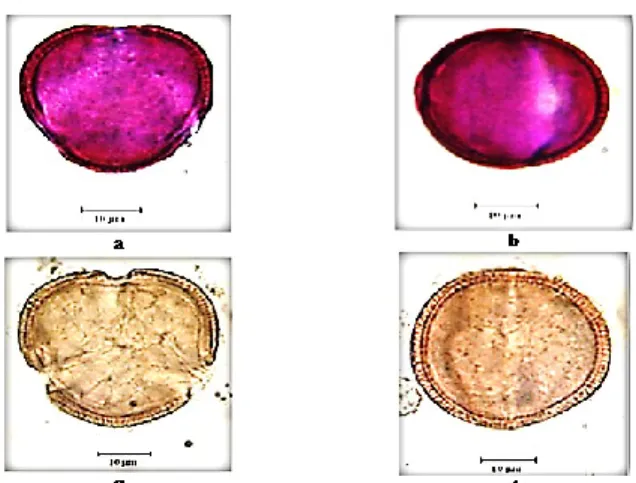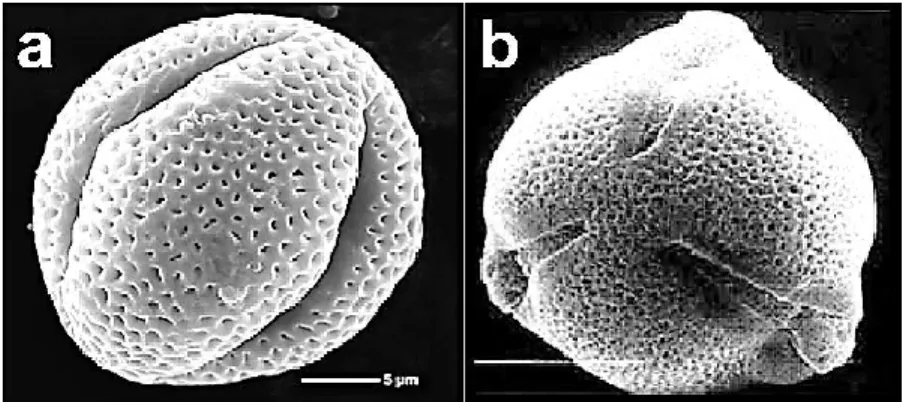Volume 27, Number 2, Pages 247-252 (2018) DOI: 10.1501/commuc_0000000221 ISSN 1303-6025 E-ISSN 2651-3749
http://communications.science.ankara.edu.tr/index.php?series=C
Received by the editors: December 08, 2018; Accepted: December 13, 2018. Key word and phrasesEuphorbiaceae, Euphorbia , pollen morphology, LM, SEM
Submitted via II. Aerobiology and Palynology Symposium 07-10 October 2018 (APAS 2018)
© 2018 Ankara University Communications Faculty of Sciences University of Ankara Series C: Biology
POLLEN MORPHOLOGY STUDIES ON TWO EUPHORBIA L. (EUPHORBIACEAE) TAXA FROM TURKEY
UMMUSEN GOKCEN, ISMUHAN POTOGLU ERKARA, OKAN SEZER, ONUR KOYUNCU, OMER KORAY YAYLACI
Abstract. Detailed morphological investigation on the pollen of two Turkish Euphorbia species (E. kotschyana Fenzl. and E. stricta L.) was carried out under light microscope and SEM. Pollen grain microphotographs of examined taxa have been taken from preparates which were made by Wodehouse and Erdtman techniques in LM. Type of the pollen grains of studied taxa have determined as tricolporate and spheroidae shape. Ornamentation is tectate-rugulate according to the Wodehouse and Erdtman methods. For E. kotschyana P/E= 1.22 (W), 0.98 (E), Exine 2.91 µm (W), 2.76 µm (E). For E. stricta, pollen grains measured as P/E= 0.89 (W), 0.94 (E), Exine 2.32 µm (W), 2.59 µm (E).
1. Introduction
The family of Euphorbiaceae is represented about 330 genera and 8.900 species all around the world. Euphorbiaceae is a cosmopolitan plant family and it has wide distribution from tropic to subtropic areas. Tropic members of Euphorbiaceae is composed of mainly shrub and three formed taxa. Euphorbiaceae has the highest biological diversity in this area [1]. Some members of Euphorbiaceae have economical importance and these taxa have many usage areas in different industries. For example, Euphorbiaceae taxa are the important source of latex. Besides some taxa are used for medicinal purposes because of their metabolites. Except from these, also they have been used as food, insecticide, seed oil source and starch source in many years [2]. Euphorbia L. is the most known genus of the Euphorbiaceae family. It composed of annual, biannual and perennial taxa which are herb, shrub or three. About 2150 Euphorbia taxa distributed in the world and so 120 of these have natural distribution in Turkey. 18 of these are endemic to Turkey and endemism ratio of it is about 6.7 % [3].
According to the recent palynological studies, many taxonomic problems were solved in the light of palynological data and so natural relationships between species and subspecies level have been identified [4-6]. Only palynological studies are not enough for classifying the plants. But they are the most important helper of classical taxonomy in this way. Marphological features and ornamentation patterns of pollen grains are accepted as diagnostic characters for the solution of taxonomic problems in species and subspecies categories.
This study aims to identify taxonomic problems between closely related taxa and obtained data from this study will contribute into taxonomic data which will be used in further studies.
2. Materials And Methods
Pollen material was obtained from the Eskişehir Osmangazi University Faculty of Science and Art Herbarium (OUFE). For LM pollen grains were prepared according to the methods of Wodehouse (1935) and Erdtman (1969) [7, 8]. LM observations of non acetolysed and acetolysed pollen were made using a Prior microscope. Non-acetolysed and acetolysed pollen were photographed with a Spot in-sight colour digital camera on an Olympus microscope equipped with an apochromatic 100× oil immersion objective and compensating 10× eyepieces. Pollen diameter, pore diameter, distance between 2 pori, and exine and intine thickness measurements were made with 50 pollen grains so that the resulting data would follow Gaussian curves. Pollen from each species was mounted on stubs using double-sided adhesive tape. Each sample was coated with a 100-A-thick layer of gold in a Polaron SC7620 rotating and tilting vacuum coating apparatus for 60 s, and scanned using a JEOL 5600 LV SEM with 20-kV accelerating voltage [9, 10]. Basic palynological books and studies were used for identification of pollen grains [7-14].
Specimens investigated— Euphorbia stricta L., Eskişehir; Mihalıççık; Üçbaşlı
Village, Annaç area, 950-980 m, 21.07.2015. Euphorbia kotschyana Fenzl, Pug., Mihalıcçık; Ahurözü Village; Between İlören and Ahurözü Villages, road side, 698 m, 15.07.2016.
FROM TURKEY
FIGURE 1. Light microscope microphotographs of E. kotschyana (a-polar view (W) b-equatorial view (W), c-polar view (E) d-b-equatorial view (E)).
FIGURE 2. Light microscope microphotographs of E. stricta (a-polar view (W) b-equatorial view (W), c-polar view (E) d-b-equatorial view (E)).
3. Results And Discussion
Pollen grains of all investigated Euphorbia taxa in this study identified as tricolporate and spheoridal shaped. Also they have tectate and rugulate ornamentation.
FIGURE 3. SEM microphotographs of investigated taxa (a-E. kotschyana, b- E. stricta). TABLE 1. Pollen morphometrical parameters of Euphorbia taxa (µm); (P: Polar axis; E:Equatorial axis; M:Mean; S: Standard deviations).
FROM TURKEY
Emphasized as in literatures, aperture features and exine structure are located between essential criteria which are used for identification of phylogenetic relationships between species [4-6, 14-16]. Obtained data from this study revealed that, all palynological differences between these studied Euphorbia taxa have parallels with genetic differences (Figure 1-3, Table 1) [4-6, 15].
We beliave that, morphological characters of pollen grains are useful tools as in systematical characteristics of taxa. Also this study will made contribution to the identification of phylogenetic relationship between investigated taxa.
References
[1] http://flora.huh.harvard.edu/china/mss/volume11/Euphorbiaceae.pdf
(accessed 11.12.2015)
[2] A. Radclife-Smith, Euphorbia. In: P.H. Davis (ed.), Flora of Turkey and the
East Aegean Islands. Edinburgh University press, Edinburgh, 7, (1982) 571-630.
[3] A. Guner, S. Aslan, T. Ekim, M. Vural, M. T. Babac (eds.), Türkiye Bitkileri
Listesi (Damarlı Bitkiler). Nezahat Gökyiğit Botanik Bahçesi ve Flora
Araştırmaları Derneği Yayını. İstanbul, (2012), 1290.
[4] D. Anefrod, The evolution of flowering plants. The evolution of life. 1.,
Chicago: University of Chicago Press, (1960).
[5] A. Cronquist, The evolution and classification of the flowering plants.
Thomas Nelson Ltd. Edinburgh, London, (1968).
[6] A.L. Takhtajan, Outline of the classification of flowering plants
(Magnoliophyta). The Botanical Review, 46, (1980).
[7] R.P. Wodehouse, Pollen Grains. Mc. GrawHill. New York, (1935).
[8] G. Erdtman, Handbook of Palynology Morphology, Taxonomy, Ecology. An
Introduction to the Study of Pollen Grains and Spores. Hafner Pub. New
York, (1969).
[9] J.W. Walker, Evolution of exine structure in the pollen of primitive
Angiosperms. American Jornal of Botany, 61, (1974) 891-902.
[10] J.W. Walker, Aperture evolution in the pollen of primitive Angiosperms.
American J ornal of Botany, 61, (1974) 1112-1137.
[11] A. Kuprianova, Apertures of pollen grains and their evolution in Angiosperms. ReviewPaleobotany and Palynology, 3, (1967) 73-80.
[12] B. Aytug, S. Aykut, N Merev, G. Edis, İstanbul Çevresi Bitkilerinin Polen
[13] K. Faegri, J. Iversen, Textbook of pollen analysis. 3rd edition. Munksgaard, Copenhagen, (1975).
[14] P. D. Moore, J. A. Webb, M. E. Collinson, Pollen Analysis. Blackwell
Scientific Publications, Oxford (1991) 226.
[15] W. Punt, Umbelliferae. In: W. Punt, G. C. S. Clarke, editors. The Northwest European Pollen Flora, Elsevier, 1, (1984) 89-123.
[16] S. Pehlivan, Türkiye’nin Alerjen Polenleri Atlası. Unal Ofset Matbaacılık
Sanayi ve Tic. Ltd. Şti., Ankara, (1995).
Current Address: UMMUSEN GOKCEN: Osmangazi University, Faculty of Arts and Science, Department of Biology, Eskişehir-Turkey.
E-mail: ummusengokcen@gmail.com.tr ORCID: https://orcid.org/0000-0001-7837-9151
Current Address: ISMUHAN POTOGLU ERKARA: Osmangazi University, Faculty of Arts and Science, Department of Biology, Eskişehir-Turkey.
E-mail: ismuhan@ogu.edu.tr
ORCID: https://orcid.org/0000-0001-5780-4999
Current Address: OKAN SEZER: Osmangazi University, Faculty of Arts and Science, Department of Biology, Eskişehir-Turkey.
E-mail : oksezer@ogu.edu.tr
ORCID: https://orcid.org/0000-0001-7304-1346
Current Address: ONUR KOYUNCU: Osmangazi University, Faculty of Arts and Science, Department of Biology, Eskişehir-Turkey.
E-mail : okoyuncu@ogu.edu.tr
ORCID: https://orcid.org/0000-0002-0364-6638
Current Address: OMER KORAY YAYLACI: Anadolu University, Faculty of Pharmacy, Department of Pharmaceutical Botany, Tepebaşı, Eskişehir, Turkey.
E-mail: okyaylaci@anadolu.edu.tr

